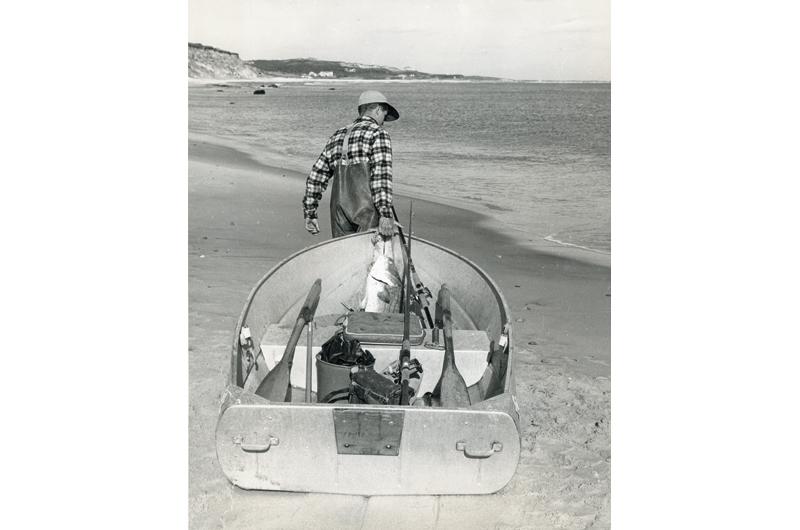Ever since Wampanoags launched canoes in pursuit of whales, fishermen have been pushing the envelope by trying to catch big fish from small boats. Kayaks are the current favorite, and their stealth and maneuverability make them very efficient at this game, albeit lacking in range and storage capacity. My friend Joe Canha, seventy years young, fishes in a fourteen-footer mostly at night for striped bass and racks up some very impressive catches, including a forty-pounder last year and another epic night when he had three fish in the thirty-pound class.
Tin boats were the kayak equivalents of my younger days, and my first forty-pound striped bass was caught in 1958 from a twelve-foot aluminum skiff piloted by Salt Water Sportsman editor Frank Woolner. We were drifting live mackerel a few hundred yards off the beach at Provincetown, and the spray from a breaching humpback whale enveloped us with pungent halitosis while I was battling my trophy. It was a game-changing moment, and “tin boats,” as we called them, would play a pivotal role in my angling life thereafter.

A couple of years later I bought a used nine-footer on the Vineyard that fitted my budget and was the right size for the roof racks of a small station wagon. It was my first boat, weighed less than a hundred pounds, rowed like a breeze, and with a three horsepower Johnson, could cover lots of inshore water that was previously inaccessible. I was living in Edgartown at the time, and Sengekontacket, Eel Pond, the Edgartown flats, Katama Bay, Cape Pogue Pond, and Pocha were now in range, and although there weren’t any breaching whales or forty-pound stripers, there was plenty of excitement with schoolies and bluefish and the thrill of exploring new and beautiful water.
Eventually the siren song of bigger game overwhelmed common sense and caution, and I started launching the boat up-Island, once even skidding it down the Gay Head Cliffs and rowing out to Devil’s Bridge in search of bass. But it was at Squibnocket that I hit pay dirt. Launching through the surf at the parking lot, I either rowed or motored within casting range of favored spots and then cast plugs to the unsuspecting inhabitants. I quickly started hooking big bass up to forty-eight pounds and found that the nine-footer was a killing machine. I was using heavy free-spool tackle with the drag tightened all the way down, and the fish would tow the boat on a “Nantucket sleigh ride” and quickly either exhaust themselves or wrap around a rock and break off.
The whole procedure was somewhat risky. I wore waders to keep dry while launching and kept them on when fishing because there wasn’t enough room in the boat to remove them. Fortunately I never fell overboard. Because the boat was small and tippy I could not stand up to cast or fight a fish. Instead, I would stand on one leg with the other kneeling on the center seat. This lowered my center of gravity and gave me sufficient support. I used a homemade eight-foot gaff to haul the bass aboard. Over the years I caught numerous large stripers with this technique and lost more than I landed because many of them would get into kelp-laden rocks and scrape the plugs off.
Then in the mid-1960s I started casting Alou Eels, whose strong, single hooks were less likely to get straightened out or torn off in the rocks. In 1967 I won the boat division of the Derby in my miniature craft using an amber Alou Bass Eel. On October 8 I launched at Squibnocket at first light, motored beyond the mussel bed, and then rowed into casting range of a rock that had been holding big fish. On my first cast I landed a forty-three-pounder, on my second cast a forty-five. The combined weight of the two fish was equal to the weight of the boat, and I didn’t dare make another cast because a third big fish might have swamped it. So after only two casts I coasted ashore on a swell with a couple of forty-plus-pounders, one of which was a Derby winner. My prize was a new pair of waders.
The following year the nine-footer succumbed to corrosion, and I moved up to a succession of larger aluminum boats and finally my present Boston Whaler, named Tin Boat out of respect and nostalgia for its predecessors. Joe Canha has invited me to get modern and try
his kayak this summer, but I think that challenge is for youngsters like him.




